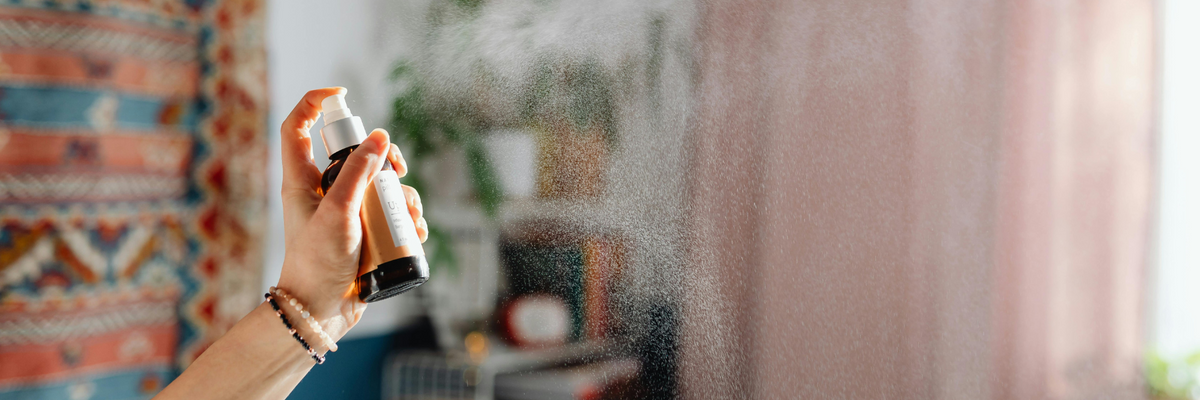
How to Make Room Sprays That Last
|
|
|
Time to read 5 min
|
|
|
Time to read 5 min
Ever wished you could bottle up a feeling? That fresh-out-of-the-wash comfort, the crisp air before a storm or that espresso hit you get when walking into a coffee shop? Room sprays are the next best thing.
And let’s face it, bad smells ruin good moods, from last night’s takeaway to damp laundry or just that odd, unidentifiable "stale air" situation. A quick spritz refreshes a space instantly.
And if you’re looking for a flame-free alternative to candles or want to diversify your product line, room sprays are simple to make, customisable and alwaaays in demand. Here’s how to make room sprays that actually work.
Before you get started, here’s what you’ll need to mix up a long-lasting, high-quality room spray:
Room spray base: A room spray base eliminates the need for multiple ingredients like solubilisers and distilled water. It's the key to a well-balanced formula that disperses fragrance evenly.
Fragrance Oil: Choose a scent that lingers—floral, fresh, citrus or cosy, depending on the ambience you want to create. Heads up: Make sure your choice is suitable for room sprays.
Room Spray Bottle: Glass or high-quality plastic will keep the formula stable and looking sleek. We recommend opting for either 100ml or 150ml bottles. Transparent is a fool proof option, but you can go for a deep amber shade for a luxe finish.
Measuring Jug: A neat measuring jug ensures accurate ratios for a well-balanced room spray.
Funnel: Our pouring jugs have a handy spout to keep pouring mess-free and precise. If not using, we suggest investing in a funnel to prevent spills!
CLP Label (if you are selling): If you intend to sell your room sprays, a compliant CLP (Classification, Labelling & Packaging) label is legally required.
Packaging, Labels & Decorative Elements (optional): Whether you're making sprays for yourself or selling them, presentation makes all the difference. You can find some of our candle packaging tips here and apply them to your room sprays.
Making a room spray is quick, simple and completely customisable. With just a few ingredients and the correct technique, you can create a long-lasting scent mist that refreshes any space instantly. Follow these steps for a balanced, well-blended formula that lasts.
You can start by measuring out your room spray base and fragrance oil. The typical ratio is 95% base and 5% fragrance oil, but always check the IFRA to ensure 5% is allowed. Using a measuring jug ensures accuracy and consistency, especially if you're making multiple bottles.
Pour the fragrance oil into the room spray base and stir gently but thoroughly. This step is crucial—proper mixing ensures that the scent distributes evenly and doesn't separate over time.
Carefully pour your blended mixture into a clean, dry spray bottle using a funnel. This keeps the process mess-free and precise, preventing spills and wasted product.
Secure the atomiser spray top onto the bottle. A good-quality atomiser is essential—it creates a fine mist rather than large droplets, ensuring the scent disperses evenly into the air.
Give the bottle a good shake to combine everything thoroughly. For best results, let your room spray sit for 24 hours before use. This allows the fragrance to bond fully with the base for a more balanced, long-lasting scent.
If you’re selling your room spray, compliance with CLP (Classification, Labelling & Packaging) is a must. Every product must have a correctly formatted CLP label detailing the fragrance blend, safety warnings, and allergens. For branding purposes, consider adding one or more of the following.
A scent name: A creative name makes the spray more appealing and recognisable.
A branded label: A clean, professional design adds credibility.
Packaging (optional): A simple box or tissue-wrapped bottle elevates the unboxing experience, especially for gifting or premium ranges.
Room sprays aren't just a home fragrance product—they're a lifestyle upgrade. Whether you're targeting busy parents, scent lovers or those looking for quick and easy ways to refresh their space, how you market them matters. Here's how to position your room sprays for maximum appeal.
Room sprays are quick and endlessly versatile: a must-have for anyone who loves a fresh-smelling home without the hassle of candles or diffusers. If you’re making them for yourself or adding them to your product line, either way, the key is long-lasting blends , smart packaging and clever marketing . Ready to get started? With the right ingredients and positioning, your room sprays could be the next best-seller.
FRAGRANCES FEATURED IN THIS BLOG
Room sprays are classified as 10B by IFRA, as they are designed to be sprayed into the air and are not meant for direct skin contact.
Currently, reed diffusers are classified as 10A by IFRA due to the high likelihood of direct skin contact when flipping the reeds. This means that while an oil may be suitable for use in a room spray, it may not be suitable for use in a diffuser. Always be sure to check the percentage values shown on the IFRA certificate for your specific product.
To make life easier, we also have direct links to oils that are suitable for reed diffusers and oils that are suitable for room sprays, as follows:
In theory, yes. However, proper testing is vital to ensure the finished product does not leave residue or stains on the fabrics. A very fine atomiser and spraying at least 40-50cm from the surface will help.
Ready to get started making room sprays?

